Bea Perks profiles Martyn Poliakoff, the internet’s favourite ‘mad professor’
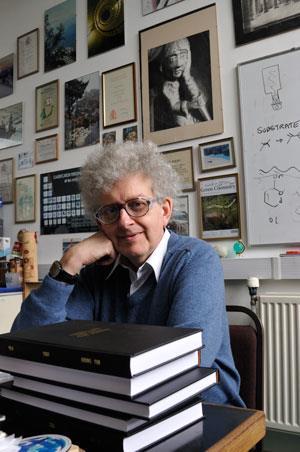
Martyn Poliakoff, foreign secretary of the Royal Society, YouTube superstar, professor of chemistry at the University of Nottingham in the UK and honorary professor of chemistry at the Moscow State University in Russia, has a dazzling array of strings to his bow. But he doesn’t hesitate when asked how he would describe himself. ‘I’m a chemist,’ he says. ‘A researcher first, and then a teacher’.
Poliakoff is famous for so many things, it’s tricky to know where to start. Some, he can’t really do anything about – his Russian ancestry, his renowned playwright brother, his properly mad-professor hair – but for others, for the important stuff, he must take full credit. As a research chemist at Nottingham, he has pushed the boundaries of green chemistry, focusing on the development of environmentally acceptable chemical processes and materials.
Born in London in 1947, Poliakoff was the first son of an English mother and a Russian father. His father, Alexander Poliakoff, a physicist who became chairman of Multitone Electronics, had left Russia with his parents in the 1920s. The Poliakoffs had lived in the heart of Moscow, with Alexander’s nursery window overlooking the Kremlin. After the October 1917 coup, their flat, their car and his father’s company were confiscated by Lenin’s government. The family came to London in 1924 when Alexander was 14.
Martyn Poliakoff’s father was one of many physicists in the family. ‘My father was a physicist, my Russian grandfather was a physicist, my parents-in-law were both physicists, and also my wife’s grandfather was a physicist,’ he says. ‘I’m surrounded by physicists!’ Martyn rather let the side down, although not as gravely as his literary brother, Stephen, who didn’t even study science.
Joint honours
Despite the ‘failure’ of these two brothers, both have become leaders in their fields. Both have been appointed Commander of the Order of the British Empire – Martyn for services to science and Stephen, to drama. In 2008, the brothers were both awarded honorary doctorates by the University of East Anglia – Stephen for letters and Martyn for science. ‘A great excuse for a big family party,’ Martyn said at the time.
To have turned out two such exceptional individuals suggests their parents were very encouraging. ‘Our parents were supportive,’ agrees Martyn, ‘but in some rather unconventional ways.’
He particularly regrets his mother’s belief that it was harmful to bring up children as bilingual. It didn’t stop him learning Russian, but it delayed the process, only learning with his Russian grandmother when he was 14. The language comes in useful now: he has collaborated with Russian research groups since 1990, had several Russian co-workers and supervised three PhD students in Russian. As well as sharing the title of honorary professor at Moscow State University with Fidel Castro and Bill Clinton, he is a foreign member of the Russian Academy of Sciences.
Poliakoff has visited Russia six times since becoming foreign secretary of the Royal Society in 2011, and regrets the inevitable halt to such trips following recent events in Ukraine. As foreign secretary of the Royal Society, Poliakoff joins an elite band. The Royal Society has four officers – a biological sciences secretary, a physical sciences secretary, a foreign secretary and a treasurer (materials scientist Anthony Cheetham) – who work alongside the president (geneticist Paul Nurse). Poliakoff was elected foreign secretary in 2011, a position he can hold for up to five years. He is responsible for overseeing Royal Society international business. Previous foreign secretaries (going back to 1723) have included Joseph Lister, father of antiseptic surgery, and Cyril Hinshelwood, winner of the 1956 Nobel prize in chemistry.
Poliakoff is admirably placed for the role. Not only with his Russian connections, but also through a collaboration with Chinese green chemist Buxing Han going back over 15 years (since 1998), and as an honorary member of the Chemical Society of Ethiopia – a role he took on in 2008, three years before being made foreign secretary.
Green chemistry in Africa
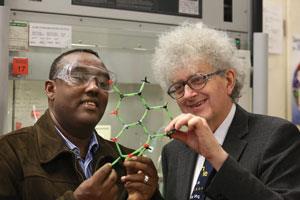
The Ethiopia link comes via Poliakoff’s son, Simon, who followed the family tradition and became a physicist. He taught for a while in Hossana, a town about 200km from Addis Ababa, and invited his father to give a talk to his pupils on green chemistry. ‘It was the first talk ever given about green chemistry in Ethiopia,’ says Poliakoff.
After the talk, the Poliakoffs went to look at Addis Ababa University. Once there, his son’s fluent Amharic (the official language of Ethiopia) so impressed resident chemist Nigist Asfaw that they were given an impromptu tour of the chemistry department. The rest is history. ‘Green chemistry has become a major theme in Ethiopia,’ says Poliakoff. The universities of Nottingham and Addis Ababa now collaborate closely; Poliakoff’s fellow chemistry professor Pete Licence has become adjunct professor at Addis, and both of them are honorary members of the Chemical Society of Ethiopia. Nottingham University has also had the UK’s first chemistry PhD students from Ethiopia.
Through the Royal Society, Poliakoff helped set up the Ethiopian Academy of Sciences. ‘It has been an enormously rewarding experience,’ he says. ‘I have become quite a strong advocate for getting African scientists into the international scientific community. My long-term vision is that Ethiopian scientists should go to an international conference and nobody should think it surprising.’
In 2012, a memorandum of understanding was signed between Nottingham and Addis Ababa universities to build on these strong links, and Ethiopia’s ambassador to the UK led a delegation to Nottingham to sign two new agreements on teaching and research. Collaborations like this between scientists in economically developed countries and their African colleagues can be inspiring and productive for everyone involved, says Poliakoff.
The benefits of green chemistry are clear in Ethiopia and other African countries where there is no indigenous oil but an ever-increasing demand for chemicals to supply a fast-growing population. It provides a unique opportunity for African chemists because it combines the search for new science with the development of sustainable chemical technologies appropriate to the needs of the community, argued Poliakoff, Asfaw and colleagues in an article in Science less than five years after Poliakoff’s first visit to Addis Ababa. ‘The resources of Africa – intense sunlight, unique plant species, and enthusiastic young people – provide its chemists with scientific opportunities that are less readily available in many other countries.’
Asked whether being foreign secretary means that Poliakoff gets to spend more time in Ethiopia, he sounds a little weary. ‘As foreign secretary you don’t spend much time anywhere,’ he sighs. Nevertheless, he cheers up audibly when explaining that he spends ‘about 60% of my time as foreign secretary, and about 60% of my time being professor of chemistry’. There aren’t enough hours in the day, but he seems to rather enjoy that.
Poliakoff’s international involvement extends well beyond Russia, China and Ethiopia as foreign secretary of the Royal Society. Indeed his influence worldwide, particularly via the web, seems to know no bounds. A visit to the Royal Society last November by Korea’s science minister Choi Mun-Kee – to strengthen collaborative partnerships with the UK – revealed that the minister was a fan of Poliakoff’s Periodic Table of Videos.
YouTube star
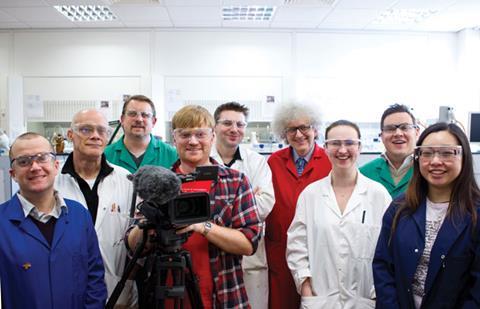
Of all his interests, honours and responsibilities, Poliakoff is perhaps best known worldwide for his YouTube presence. The Periodic Table of Videos – created by video journalist Brady Haran together with Poliakoff and chemists at the University of Nottingham – began recording in June 2008, with the intention of producing a short video about each of the 118 elements of the periodic table. Now that all 118 elements have a video, the team is updating them and making new films about other areas of chemistry. A subsequent series, The Molecular Videos (MolVids), runs alongside, including such titles as Frog poison, Alcohol and Viagra.
The videos are funded by a number of bodies – including the UK’s Engineering and Physical Sciences Research Council, industrial sponsors, a contribution from the Royal Society of Chemistry and, most significantly, the University of Nottingham. ‘In the context of corporate videos they are extremely inexpensive,’ says Poliakoff. ‘A few hundred pounds each,’ he says, adding that they aim to record one video a week.
It remains unclear exactly who is watching, since stats rely on what people put in their profiles. ‘A Nobel prize winning scientist could register as a teenage ballet dancer,’ he complains. ‘But we do get emails from people,’ he says. ‘I got an email at lunchtime today which says “Hi Prof, I cannot stop watching the chemistry videos … thank you for showing your talent for teaching and knowledge. From a 48 year old in Sweden, not a scientist, just a web surfer”.’ Recently, he received an email from an officer in the US army, who had just been on a civil support skills training course with what he called the ‘weapons of mass destruction response team’. The officer said he had passed the chemistry section of the course thanks to the videos, and asked Poliakoff if he would mind his likeness being added to their class T-shirt. Needless to say, Poliakoff was delighted.
Poliakoff’s unscripted YouTube contributions – on topics ranging from the elements, to computational chemistry, to cuts in research funding, to the chemistry of Kate Middleton’s engagement ring – have entertained and educated on a colossal scale. His favourite video, according to an interview on the RSC’s Green Chemistry blog, was about hassium (atomic number 108), where Poliakoff opens with ‘I know nothing about hassium, shall we make something up?’ It’s this apparently seat-of-the-pants delivery, coupled with a highly informed and well-researched (he knew plenty about hassium in the end) final product, that wins him a growing fan base.
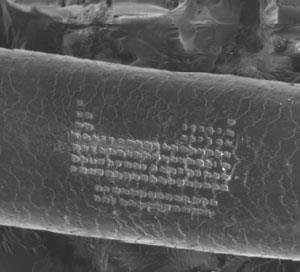
The topic of his Einstein-esque hair is alluded to on numerous occasions. ‘Part of my mission is to show that all scientists don’t look like me,’ he tells viewers in one video. Nevertheless, the fact that he does look like that has been useful to his mission. People remember him. In another video, he is given a birthday present at the University of Nottingham’s Nanotechnology Centre – an unruly strand of his hair is removed and placed in an ion beam microscope, onto which is engraved, with the help of high-speed gallium ions, a 89.67µm by 46.39µm periodic table. ‘This is by far the smallest periodic table that I’ve seen,’ he tells viewers. ‘Obviously it’s the best because it’s on my hair.’
Poliakoff’s research over the past 20 years has shifted over to the border between chemistry and chemical engineering. His focus is now firmly on green chemistry: ‘A cleaner way of making chemicals.’
Exam results aren’t everything
‘Most of my research at the moment is in various aspects of organic chemistry,’ he says. ‘I believe I failed my organic chemistry exam, so it’s quite funny that I should now find myself in this position.’ Poliakoff graduated from the University of Cambridge with a 2:2 degree – a result he divulges to students worrying about impending exams.
In partnership with Nottingham colleague Mike George, Poliakoff is currently looking at ways of synthesising malaria drugs. ‘Your current project is always your most exciting,’ he says. Despite major progress in the worldwide fight against malaria, the World Health Organization (WHO) recorded 207 million cases of malaria and an estimated 627,000 deaths in 2012. The disease is most prevalent in developing countries where resources are lowest and the cost of medicines can be prohibitive. The team hopes to reduce the cost of antimalarial drugs by making them photochemically.
Your current project is always your most exciting
His work on malaria drugs began before he became an officer of the Royal Society, but since taking on that role he has travelled to many more countries where malaria is endemic. His research interest stems from the fact that some compounds with antimalarial activity are best made photochemically. ‘Early in my career I was a photochemist, and now I’m working with Mike George to try and make photochemistry a more useful approach for manufacturing chemicals and molecules,’ he says.
Since the malaria parasite Plasmodium falciparum began developing resistance against the one-time antimalarial favourite, quinine, a new drug, artemisinin, has taken its place. Artemisinin-based combination therapies are now the WHO-recommended front-line treatment. It is commonly extracted from the plant Artemisia annua (sweet wormwood), which is an expensive process that is dependent on the success or otherwise of the harvest. Artemisinin is a lactone with a 1,2,4-trioxane core structure, and synthetic derivatives of artemisinin have been shown to have excellent antimalarial activity.
Last year, Poliakoff, George and colleagues reported the synthesis of antimalarial trioxanes via continuous photo-oxidation with singlet oxygen in supercritical carbon dioxide. Unlike previously used solvents, such as chloroform, supercritical carbon dioxide provides a non-toxic and non-flammable reaction medium that can be used close to ambient temperature. Oxidation in it also turns out to be slightly quicker than with many conventional solvents, probably because gaseous oxygen is fully miscible in supercritical carbon dioxide, allowing for single-phase reaction conditions.
Happy families
In Russia, Poliakoff’s collaborations, going back nearly 25 years, all started on a fairly small scale, but went on to involve several researchers in his department, continuing ‘through literally generations of researchers on both sides’, he says.
The role of Poliakoff’s son in triggering what was to become such an important collaboration between Ethiopia and the UK cannot be underestimated. Likewise the role of his Russian forebears – his father (and grandfather before him) for fostering a scientific inquisitiveness, and his grandmother for teaching him how to speak Russian – set the foundation for a series of rewarding collaborations.
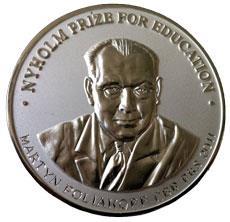
Continuing the theme, Poliakoff has clearly been touched by two collaborations on a slightly different scale. In 2012, a young YouTube fan of his from Italy, Edoardo, came over to the University of Nottingham with his mother to celebrate his 10th birthday. He was shown around the labs and attended a demonstration lecture aimed at A-level students. His obvious enjoyment made it a particularly rewarding experience, says Poliakoff, and reminded him of the value of the YouTube project.
In 2011, Poliakoff was awarded the Nyholm Prize by the RSC for taking chemistry to the widest possible audience. In response, he made a video about Australian inorganic chemist Ronald Nyholm after whom the award is named. Many inorganic chemists are aware of Nyholm’s work with Ron Gillespie in developing the valence shell electron pair repulsion approach to molecular structure, previously called the Gillespie–Nyholm theory. Poliakoff explained, with the help of a selection of dog toys shaped like molecules and customised deely boppers, how Nyolm’s work helped make inorganic chemistry what it is today.
‘As a result of the YouTube video, I got an email from Nyholm’s son living in Texas,’ recalls Poliakoff, ‘I didn’t even know he had children.’ In recognition of the prize, Poliakoff gave a lecture which, to his delight, was attended by Nyholm’s daughter and granddaughter. ‘It was a very moving occasion,’ says Poliakoff, ‘It’s the closest I’ve ever come to bursting into tears while giving a lecture.’
Bea Perks is a science writer based in Cambridge, UK
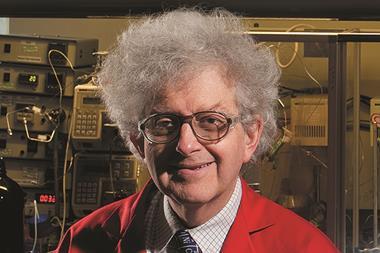











No comments yet